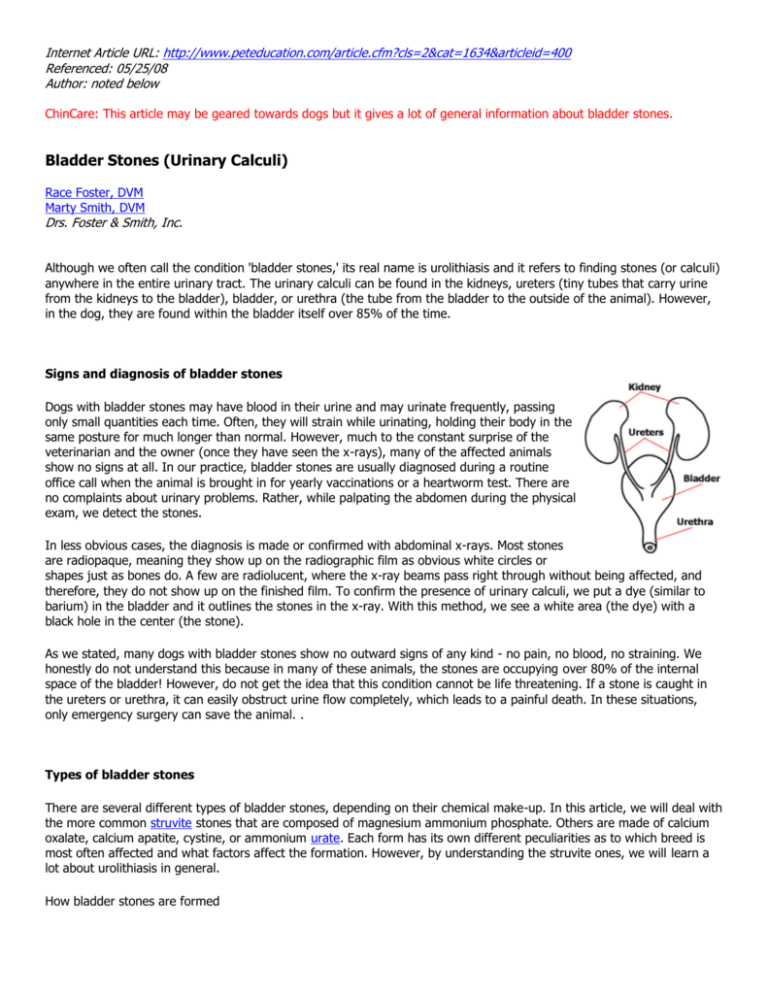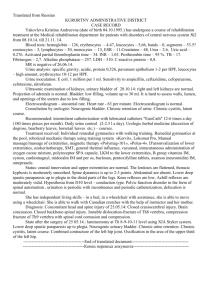doc - ChinCare.com
advertisement

Internet Article URL: http://www.peteducation.com/article.cfm?cls=2&cat=1634&articleid=400 Referenced: 05/25/08 Author: noted below ChinCare: This article may be geared towards dogs but it gives a lot of general information about bladder stones. Bladder Stones (Urinary Calculi) Race Foster, DVM Marty Smith, DVM Drs. Foster & Smith, Inc. Although we often call the condition 'bladder stones,' its real name is urolithiasis and it refers to finding stones (or calculi) anywhere in the entire urinary tract. The urinary calculi can be found in the kidneys, ureters (tiny tubes that carry urine from the kidneys to the bladder), bladder, or urethra (the tube from the bladder to the outside of the animal). However, in the dog, they are found within the bladder itself over 85% of the time. Signs and diagnosis of bladder stones Dogs with bladder stones may have blood in their urine and may urinate frequently, passing only small quantities each time. Often, they will strain while urinating, holding their body in the same posture for much longer than normal. However, much to the constant surprise of the veterinarian and the owner (once they have seen the x-rays), many of the affected animals show no signs at all. In our practice, bladder stones are usually diagnosed during a routine office call when the animal is brought in for yearly vaccinations or a heartworm test. There are no complaints about urinary problems. Rather, while palpating the abdomen during the physical exam, we detect the stones. In less obvious cases, the diagnosis is made or confirmed with abdominal x-rays. Most stones are radiopaque, meaning they show up on the radiographic film as obvious white circles or shapes just as bones do. A few are radiolucent, where the x-ray beams pass right through without being affected, and therefore, they do not show up on the finished film. To confirm the presence of urinary calculi, we put a dye (similar to barium) in the bladder and it outlines the stones in the x-ray. With this method, we see a white area (the dye) with a black hole in the center (the stone). As we stated, many dogs with bladder stones show no outward signs of any kind - no pain, no blood, no straining. We honestly do not understand this because in many of these animals, the stones are occupying over 80% of the internal space of the bladder! However, do not get the idea that this condition cannot be life threatening. If a stone is caught in the ureters or urethra, it can easily obstruct urine flow completely, which leads to a painful death. In these situations, only emergency surgery can save the animal. . Types of bladder stones There are several different types of bladder stones, depending on their chemical make-up. In this article, we will deal with the more common struvite stones that are composed of magnesium ammonium phosphate. Others are made of calcium oxalate, calcium apatite, cystine, or ammonium urate. Each form has its own different peculiarities as to which breed is most often affected and what factors affect the formation. However, by understanding the struvite ones, we will learn a lot about urolithiasis in general. How bladder stones are formed All bladder stones, whether they are struvite or any other type, are formed by minerals, which first precipitate out in the urine as individual microscopic crystals. Over time, these crystals unite and small grains of sand are formed. Once these first grains are present, additional precipitation forms on their surface and the tiny specks are gradually built into stones that sometimes reach 3" to 4" in diameter. As a simple example, this is the same process that occurs when you put sugar into a hot cup of coffee. At first it all dissolves, but as the liquid cools, its carrying capacity decreases and the sugar returns to its granular form. There is no such temperature change in the bladder, but the dissolved minerals still precipitate out in the form of microscopic crystals. If this happened only rarely, no harm would be done as they would be flushed out of the body with the urine. In certain animals, however, large quantities of minerals are rapidly formed and clinical urolithiasis develops. . What causes bladder stones? The process is really quite simple, but what causes it to occur only in certain dogs, cats, or humans? As we understand it today, the factors that bring it about are genetic predisposition, bacterial infections, diet, and urine pH. Any one of these could be solely responsible, but it is usually a combination of any or all of them. Genetics: Whenever we describe any medical condition, it seems we always have to mention genetics. We sometimes worry that our readers think we are trying to place blame for all of these conditions on the shoulders of either the breeders or the dog owners. But stop and think about it for a second. Every day on radio or television, we are told of how a researcher just isolated the gene that causes Cystic Fibrosis, Parkinson’s Disease, colon cancer, etc. Genetics has the same effect in veterinary medicine as it does in human medicine. Our problem is that in animal research, we are years behind in this area. We are left with trying to determine which animals show and/or carry the defective gene in question and then eliminating them from the breeding population. If diet were the sole answer, would not all dogs fed the wrong diet develop stones? Think how much easier it would be for good breeders if veterinarians could test puppies and determine which ones were carrying the gene that caused them to develop hip dysplasia. Someday, we will be able to do this. But for the near future, breeders are left with the older methods of trial and error as they attempt to accentuate the good traits and eliminate or reduce the less desirable ones. It is the same with struvite stones. The genetically controlled physiology of some animals causes them to produce within their bodies the higher levels of the substances that are precursors of the crystals. They are then excreted or formed in the urine. We have no way of testing to predetermine in which individual dog or line of dogs it will occur, but from experience, we can tell you that the incidence is much higher in the Pekingese, Dachshund, Miniature Schnauzer, Dalmatian, Pug, Bulldog, Welsh Corgi, Beagle, Basset Hound, and Cocker Spaniel breeds. Once an individual animal has developed stones within the urinary tract, we might recommend against breeding it. We say might because we may determine that some of the following other factors may have been predominant causes of the problem. Bacterial Infections: Bacterial infections of the bladder (referred to as cystitis) play a large role in struvite stone information for two reasons: (1) they tend to make the urine more alkaline (with pH higher than 7.0) and (2) by-products of their metabolism actually initiate chemical reactions that cause the magnesium ammonium phosphate crystals to form. Most bacterial infections of the bladder tend to raise the pH of the urine. This is important in this specific condition as struvite crystals are more apt to remain in solution if the liquid is acidic (with a pH lower than 7.0). That is, they would continue to be dissolved in the liquid and no crystals would form. Additionally, many of the bacteria that cause a cystitis also produce an enzyme (a compound that causes chemical reactions to occur) called urease. This enzyme starts the process to be reacting with urea molecules found in the urine to form ammonia and carbon dioxide. The ammonia is slowly converted to ammonium ions, while the carbon dioxide unites with other compounds, freeing up phosphates. Then, through a chain of chemical reactions that seem to feed on each other and at the same time raise the pH of the urine into the alkaline range even more, the magnesium that is normally present within the urine unites with the ammonium and phosphate to form magnesium ammonium and phosphates (struvite). If the crystals are formed rapidly and in large quantities, they will unite together to form stones. However, if only small amounts are formed over a longer period of time, they would simply be flushed out in the urine without producing any problems. Diet: Diet also plays a role in struvite formation. The urea that we mentioned above is formed when protein within the bladder is broken down by bacteria. The body's breakdown of large dietary proteins into smaller molecules also produces urea. Diets with excessively high levels of proteins simply provide the system with more urea to work with in the formation of ammonium and carbon dioxide. In truth, this may be the only factor in animals fed all-meat diets. Commercially prepared dog foods, even the highest protein varieties, would not be a factor in most animals. . Treatment Treatment of urolithiasis allows choices for the owners and veterinarians - that is, either to treat medically or surgically. In most cases, we prefer to handle these with a combination approach. In situations where a stone has lodged in the ureters or urethra, surgery is of course mandatory. We are dealing with a life or death matter that must be resolved immediately. Urinary obstructions lead to kidney shut down and death. However, in typical cases where the stones are found only in the bladder, choices can be made. Surgery: The surgical removal of stones within the bladder is referred to as cystotomy, meaning an opening of the bladder. This is usually a very easy procedure. Most veterinarians would agree that it requires less skill than a spay. With the dog under anesthesia and lying on its back, an incision is made through the ventral abdominal wall in front of the pelvis. The bladder is exposed and lifted out through the incision. It is then opened, urine is collected for culture and analysis, and the stones are removed. We usually flush the bladder and urethra with sterile saline solution to wash out any small or microscopic particles. The bladder is then closed with sutures as is the abdominal wall. The patient is placed on antibiotics and sent home the following day. The stones are sent to a laboratory for analysis to determine their chemical make-up and the remainder of the therapy will vary depending on the results. If there are stones caught in the urethra, which is especially common in male dogs, we try to back-flush them into the bladder before it is opened. If this cannot be done, an incision must be made directly through the urethral wall where the stone is located. In the rare case where stones are lodged in a ureter, an incision would have to be made at the site. Some work is being done using ultrasonic waves to destroy stones in these situations, but it is not readily available for all practices. This technique is common in human medicine and may eliminate surgery. Medical Therapy: Medical therapy can be used by itself or in conjunction with the surgery. After the diagnosis and x-rays, pretreatment laboratory work entails culturing the urine for bacteria and a urinalysis to determine what type of crystals are present along with the pH of the urine. Armed with this knowledge, we follow the obvious path. If there is a cystitis present, a culture and sensitivity is done to determine the appropriate antibacterial medications to use and then treatment is initiated. After we determine what crystals are present in the urine, we know what type of stone is probably present and we try to modify the dog's metabolism and urine to prevent further formation. This entails altering the urine pH, increasing water consumption, inhibiting the activity of urease, and use of special foods. Urinary Acidifiers: As we said, struvite stones form in alkaline urine. In these cases, we would use medications that acidify the urine hoping they will keep the magnesium ammonium phosphate crystals dissolved and prevent them from precipitating out in the urine. Examples of such medications would be ascorbic acid (Vitamin C) and dl-methionine. Some of the other less common types of stones (that we did not discuss) form in an acidic urine, so with these, we may want to make the urine more alkaline. To counter the activity of urease that is produced by the bacteria, we may also use a compound called acetohydroxamic acid. It prevents urease from breaking the urea down into ammonium and carbon dioxide molecules and this can, in some cases, greatly reduce struvite formation. Remember: Do NOT give urinary acidifiers when you are using one of the specialty diets that also acidify urine. Diet Alteration: Diet alternation may be as helpful as anything in the medical treatment NOTE: Do NOT use a urinary of struvite urolithiasis. The S/D Diet produced by Hill's can actually cause the stones acidifier and s/d, c/d, or a even large ones - to dissolve completely. Other companies such as Purina and Waltham similar diet at the same time. have also developed special diets available through your veterinarian. These diets take time, often 60 to 180 days, to work. The principle by which S/D works is that it contains lower than normal levels of large proteins, magnesium, and phosphorous. Less protein means less urea, and therefore, less ammonium and carbon dioxide formed by the action of urease. Remember that struvite is made up of magnesium and phosphate ions, so lower levels of these materials also decrease the quantity of crystals that can potentially be formed. Feeding S/D helps the urine become more acidic. And last but not least, Hill's has slightly increased the sodium chloride (normal table salt) to increase water consumption by the animal, thereby increasing a flushing action through the bladder and better keeping the crystals in solution. However, S/D cannot be used indefinitely as a preventive because it is not considered a complete diet. Also, it is not recommended for use in patients suffering from heart failure or kidney disease because of its salt and protein levels. We have never had a problem with its use except that according to the behavior of some dogs, the flavor must leave something to be desired. After the initial 60 to 150 day period, when medical therapy is actively attempting to dissolve the stones or sand that is present in the bladder, the animal is removed from S/D and placed on a normal but low protein diet. Long term therapy, which might continue over a period of years, would include urinary acidifiers and lightly salting the food on a daily basis. In our practice, we typically try to use the best of both worlds, combining surgery with the above medical protocol. During the surgery, it is easy to remove all the stones and materials that can be detected with the naked eye. Smaller particles may still unknowingly be left behind and serve as a nidus onto which crystals can precipitate in the formation of new stones. Therefore, wherever possible, we choose to follow surgery with some or all of the above medical treatments. The medical therapy helps to dissolve any materials left behind and alter the animal’s physiology to prevent more from being formed. This has significantly reduced the percentage of recurrence in our clinic. There are two final points to consider. First, please remember that the above system was directed at only one of the five different types of bladder stones found in dogs. Each type has its own peculiarities as to the medical portion of the treatment. Surgery will remain the same regardless of the chemical composition of the stone. And secondly, please remember the old expression used in human medicine, "Once a stone former, always a stone former!" The same is true for the canine. No matter how we treat some individuals, the problem will reoccur with time. Genetics definitely plays a role.





